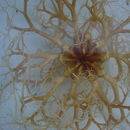en
names in breadcrumbs


"On the west coast of North America from Alaska to California, the Bering Sea to the Sea of Japan, Okhotsk Sea, Laptev Sea, across the Arctic to Greenland, Finmark, Spitzbergen, and south to Cape Code; 8-1850 metres." (Lambert, Austin 2007)
"Disc: Up to 14 cm in diameter, indented between the radial shields and covered with thick skin. The radial shields taper towards the centre where they nearly meet with opposite shields; they are densely covered with scales bearing rough granules.
Arms: Branching and coiling at the tips, the arms are higher than their width in cross-section and have up to five lateral arm spines, four or fewer on distal branches. The spines have hooks with three teeth. Hooks are also borne on the vertical ridges of embedded plates on the dorsal and lateral arm surfaces.
Mouth: Contains spine-like teeth and oral papillae.
Colour: Usually tan with dark brown markings on the dorsal side of the disc, but throughout its range this species can be maroon, reddish, orange, salmon, pink and white." (Lambert, Austin 2007)
"The sex ratio of animals around the San Juan Islands is about 1:1, with 2.6 per cent hermaphrodites. The gonads grow during the summer, and spawning occurs from October to February. New gametes begin to form immediately after spawning, but development pauses until later in the cycle when final maturation takes place. This pause corresponds to a seasonal reduction in plankton density. Early larvae have no locomotory structures and they appear to be passively captured by Gersemia polyps, in which they being their life history. Animals grow rapidly up to a disc size of 5.5 cm." (Lambert, Austin 2007)
"Juveniles of this species inhabit the pharynx of the feeding polyps of the sea strawberry Gersemia up to a size of 0.5 cm disc diameter. At this stage they possibly intercept the food collected by the polyp. Later they can be found attached to adult basket stars while feeding on plankton. Up to five young were found clinging to an adult. As adults they attach to the substrate with some of their arms and extend the others into the water in a dish-like shape facing the current. Plankton caught by hooks on the arms are rolled up in strings of mucus, and then transferred to the mouth. In the stomach, prey are wrapped in bundles of mucus. Gorgonocephalus eucnemis eats mostly crustaceans and arrow worms with an occasional fish embryo or jellyfish. Without cilia on the arms, this species will not likely capture unicellular organisms." (Lambert, Austin 2007)
Gorgonocephalus eucnemis is a species of basket star in the class Ophiuroidea. It is found in circumpolar marine environments in the Northern Hemisphere. The scientific name for the genus comes from the Greek, gorgós meaning "dreadful" and cephalus meaning "head", and refers to the similarity between these basket stars and the Gorgon's head from Greek mythology with its writhing serpents for hair.[2] The specific name eucnemis is from the Greek "good" and "boot".[3]
Gorgonocephalus eucnemis has a central disc up to 14 cm (5.5 in) across with five pairs of arms that branch dichotomously into smaller and smaller subdivisions. Its colour is varying shades of white and beige, often with a darker disc. It has an endoskeleton of calcified ossicles and is covered in a fleshy layer of skin giving it a rubbery appearance. The arms are covered in tiny hooks and spines which can be used to grip and manipulate food particles.[2][4]
G. eucnemis is found in the Arctic Ocean[5] and northern parts of the Atlantic Ocean as far south as the Faroe Islands and Massachusetts. It also occurs in the Pacific Ocean from the Bering Sea south to Japan and Laguna Beach, California. It is mostly found in rocky areas with strong currents at depths to 2,000 m (6,600 ft), but is most common at depths of 15 to 150 m (49 to 492 ft). It is also found on mud and sandy seabeds among boulders, sea pens, and sea fans.[6]
It feeds by perching in an elevated position and extending its arms in a net-like fashion perpendicular to the current. The branches and branchlets twist and coil, making it resemble an animated bush.[6] It ensnares small crustaceans such as the northern krill (Meganyctiphanes norvegica), copepods, chaetognaths, jellyfish, and detritus that come within reach. Trapped prey becomes the centre of a "knot" where it is immobilised by the secretion of mucus. Further coiling of the branches brings the food to the mouth which is on the underside of the central disc. Here, the branchlets are passed through a comb-like structure which removes the food particles. There is no anus and any undigested fragments are expelled through the mouth.[2][4][6]
Individual basket stars are either male or female. After spawning, the larvae become part of the plankton and disperse with the currents.[4]
G. eucnemis is cryptic and remains well hidden during the day. It is protected by the toxic nature of the sponges where it lurks, but is sometimes eaten by fish and crabs. It has been observed to return to a specific location regularly.[4]
It is often found living in association with sponges and soft corals in the genus Gersemia, hiding under them or in the folds of the sponges during the day and using them as elevated platforms for searching for prey at night.[4] In Puget Sound, juveniles have been found to be living and apparently feeding inside the pharynges of Gersemia rubiformis polyps, only emerging when sufficiently grown to fend for themselves.[6]
Gorgonocephalus eucnemis is a species of basket star in the class Ophiuroidea. It is found in circumpolar marine environments in the Northern Hemisphere. The scientific name for the genus comes from the Greek, gorgós meaning "dreadful" and cephalus meaning "head", and refers to the similarity between these basket stars and the Gorgon's head from Greek mythology with its writhing serpents for hair. The specific name eucnemis is from the Greek "good" and "boot".